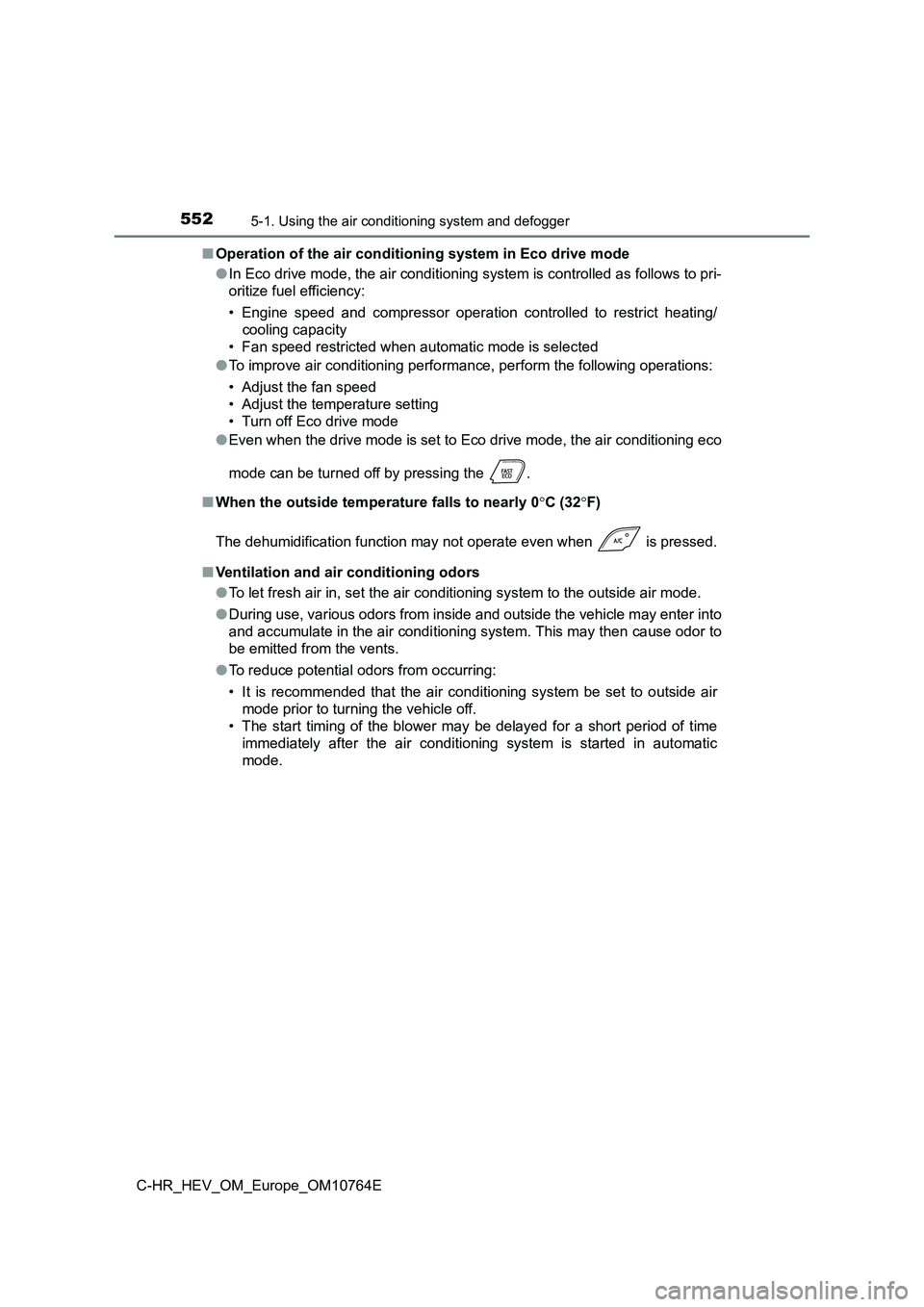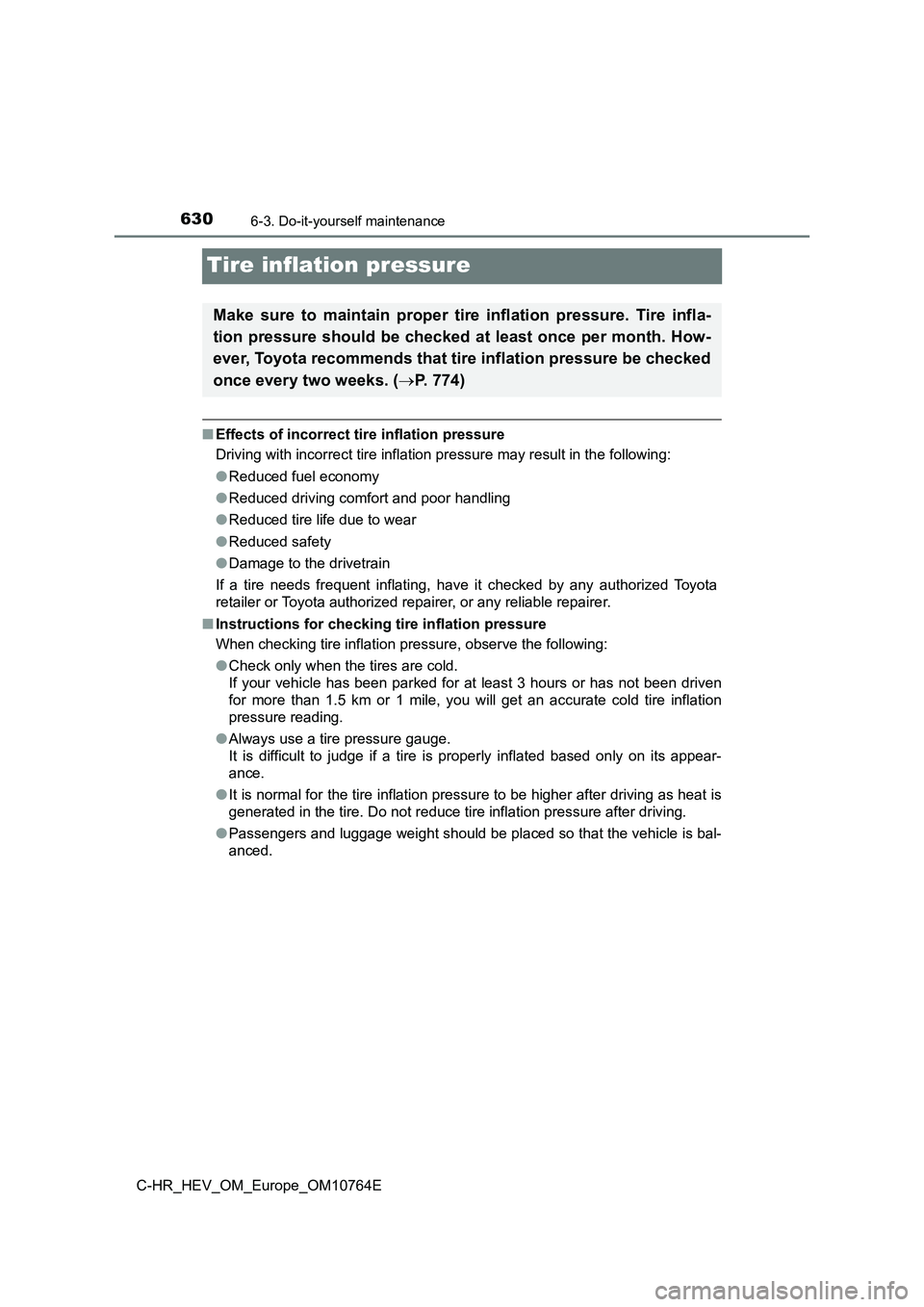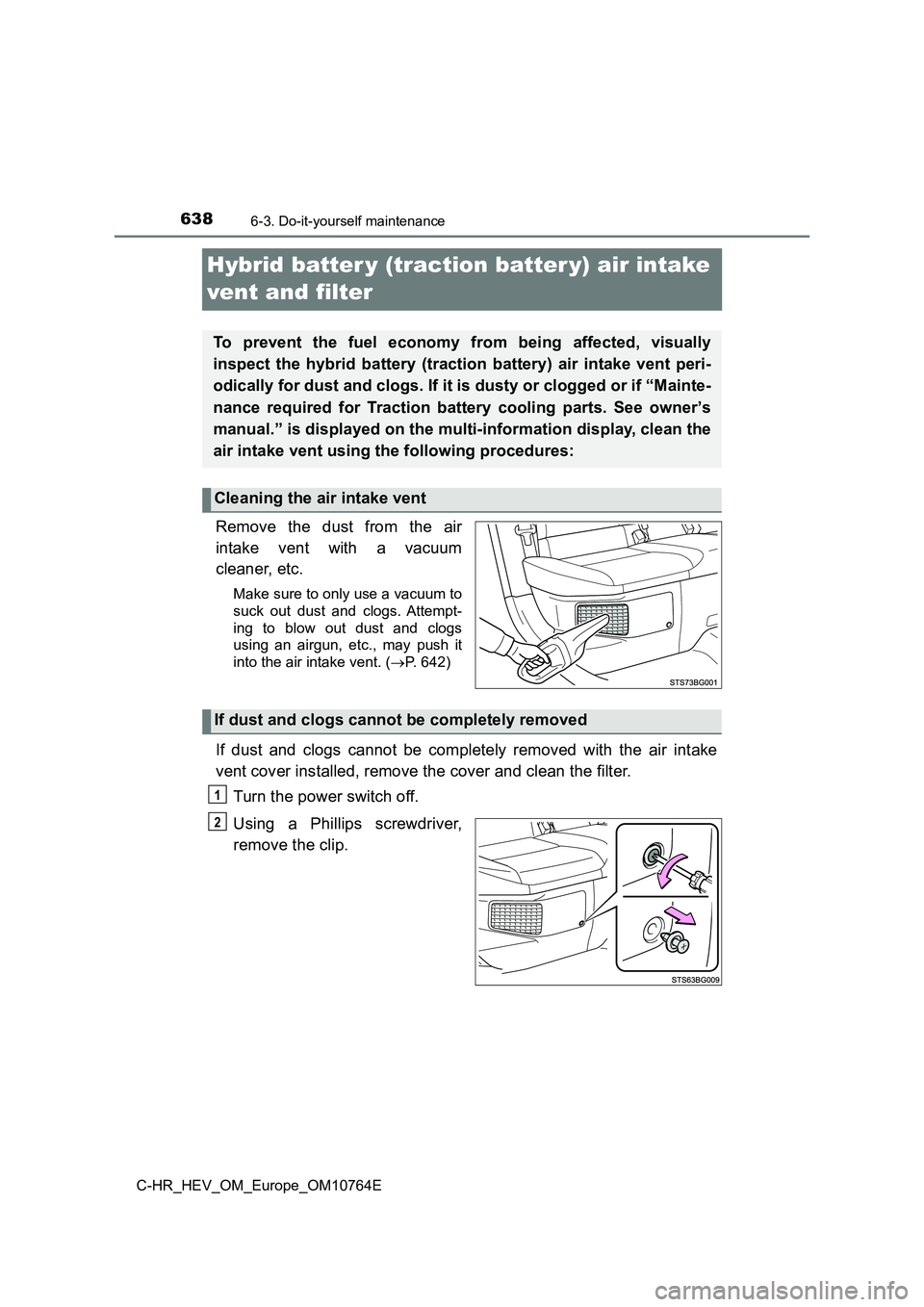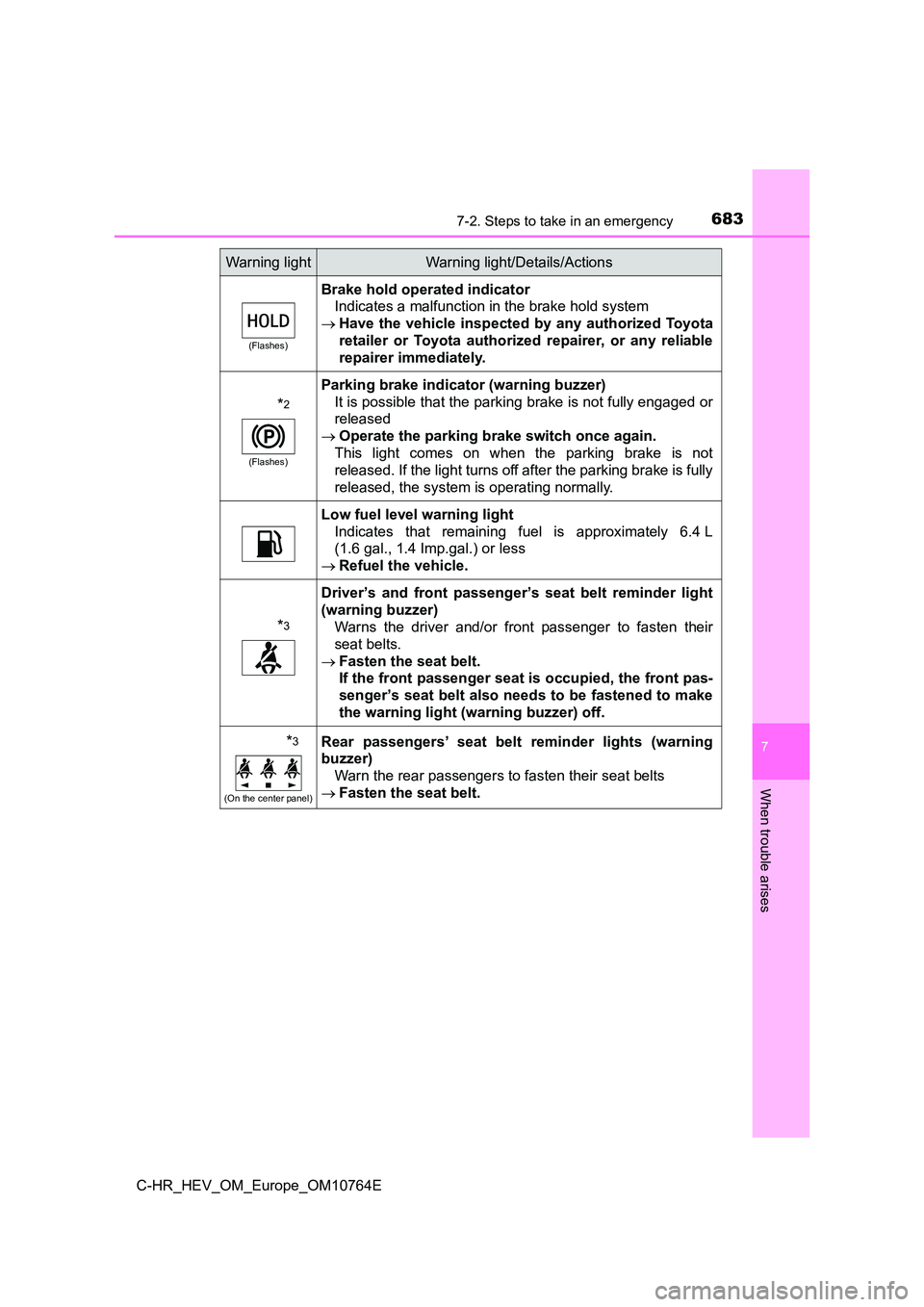2023 TOYOTA C-HR fuel
[x] Cancel search: fuelPage 542 of 814

5404-6. Driving tips
C-HR_HEV_OM_Europe_OM10764E
◆Checking tire inflation pressure
Make sure to check the tire inflation pressure frequently. Impr oper
tire inflation pressure can cause poor fuel economy.
Also, as snow tires can cause large amounts of friction, their use on
dry roads can lead to poor fuel economy. Use tires that are app ro-
priate for the season.
◆Luggage
Carrying heavy luggage will lead to poor fuel economy. Avoid ca rry-
ing unnecessary luggage. Installing a large roof rack will also cause
poor fuel economy.
◆Warming up before driving
Since the gasoline engine starts up and cuts out automatically
when cold, warming up the engine is unnecessary. Moreover, fre-
quently driving short distances will cause the engine to repeat edly
warm up, which can lead to excess fuel consumption.
Page 554 of 814

5525-1. Using the air conditioning system and defogger
C-HR_HEV_OM_Europe_OM10764E
■ Operation of the air conditioning system in Eco drive mode
● In Eco drive mode, the air conditioning system is controlled as follows to pri-
oritize fuel efficiency:
• Engine speed and compressor operation controlled to restrict h eating/
cooling capacity
• Fan speed restricted when automatic mode is selected
● To improve air conditioning performance, perform the following operations:
• Adjust the fan speed
• Adjust the temperature setting
• Turn off Eco drive mode
● Even when the drive mode is set to Eco drive mode, the air conditioning eco
mode can be turned off by pressing the .
■ When the outside temperature falls to nearly 0C (32F)
The dehumidification function may not operate even when is pre ssed.
■ Ventilation and air conditioning odors
● To let fresh air in, set the air conditioning system to the outside air mode.
● During use, various odors from inside and outside the vehicle may enter into
and accumulate in the air condi tioning system. This may then cause odor to
be emitted from the vents.
● To reduce potential odors from occurring:
• It is recommended that the air conditioning system be set to o utside air
mode prior to turning the vehicle off.
• The start timing of the blower may be delayed for a short peri od of time
immediately after the air conditioning system is started in aut omatic
mode.
Page 594 of 814

5926-3. Do-it-yourself maintenance
C-HR_HEV_OM_Europe_OM10764E
Tire inflation
pressure
( P. 630)
• Tire pressure gauge
• Compressed air source
Washer fluid
( P. 609)
• Water or washer fluid containing antifreeze (for win-
ter use)
• Funnel (used only for adding water or washer fluid)
WARNING
The engine compartment contains many mechanisms and fluids that may
move suddenly, become hot, or become electrically energized. To avoid death
or serious injury, observe the following precautions.
■ When working on the engine compartment
● Make sure that the “ACCESSORY” or “IGNITION ON” on the multi-infor-
mation display and the “READY” indicator are both off.
● Keep hands, clothing and tools away from the moving fan.
● Be careful not to touch the engine, power control unit, radiator, exhaust
manifold, etc., right after driving as they may be hot. Oil and other fluids
may also be hot.
● Do not leave anything that may burn easily, such as paper and rags, in the
engine compartment.
● Do not smoke, cause sparks or expose an open flame to fuel or the 12-volt
battery. Fuel and 12-volt battery fumes are flammable.
● Be extremely cautious when working on the 12-volt battery. It contains poi-
sonous and corrosive sulfuric acid.
● Take care because brake fluid can harm your hands or eyes and damage
painted surfaces. If fluid gets on your hands or in your eyes, flush the
affected area with clean water immediately. If you still experi ence discom-
fort, consult a doctor.
■ When working near the electric cooling fans or radiator grille
Be sure the power switch is off.
With the power switch in ON mode, the electric cooling fans may automati-
cally start to run if the air conditioning is on and/or the coo lant temperature
is high. ( P. 604)
■ Safety glasses
Wear safety glasses to prevent flying or falling material, flui d spray, etc.,
from getting in your eyes.
ItemsParts and tools
Page 632 of 814

6306-3. Do-it-yourself maintenance
C-HR_HEV_OM_Europe_OM10764E
Tire inflation pressure
■Effects of incorrect tire inflation pressure
Driving with incorrect tire inflation pressure may result in th e following:
● Reduced fuel economy
● Reduced driving comfort and poor handling
● Reduced tire life due to wear
● Reduced safety
● Damage to the drivetrain
If a tire needs frequent inflating, have it checked by any auth orized Toyota
retailer or Toyota authorized repairer, or any reliable repaire r.
■ Instructions for checking tire inflation pressure
When checking tire inflation pressure, observe the following:
● Check only when the tires are cold.
If your vehicle has been parked for at least 3 hours or has not been driven
for more than 1.5 km or 1 mile, you will get an accurate cold t ire inflation
pressure reading.
● Always use a tire pressure gauge.
It is difficult to judge if a tire is properly inflated based o nly on its appear-
ance.
● It is normal for the tire inflation pressure to be higher after driving as heat is
generated in the tire. Do not reduce tire inflation pressure af ter driving.
● Passengers and luggage weight should be placed so that the vehicle is bal-
anced.
Make sure to maintain proper tire inflation pressure. Tire infl a-
tion pressure should be checked at least once per month. How-
ever, Toyota recommends that tire inflation pressure be checked
once every two weeks. ( P. 7 7 4 )
Page 640 of 814

6386-3. Do-it-yourself maintenance
C-HR_HEV_OM_Europe_OM10764E
Hybrid batter y (traction batter y) air intake
vent and filter
Remove the dust from the air
intake vent with a vacuum
cleaner, etc.
Make sure to only use a vacuum to
suck out dust and clogs. Attempt-
ing to blow out dust and clogs
using an airgun, etc., may push it
into the air intake vent. ( P. 642)
If dust and clogs cannot be completely removed with the air intake
vent cover installed, remove the cover and clean the filter.
Turn the power switch off.
Using a Phillips screwdriver,
remove the clip.
To prevent the fuel economy from being affected, visually
inspect the hybrid battery (traction battery) air intake vent p eri-
odically for dust and clogs. If it is dusty or clogged or if “M ainte-
nance required for Traction battery cooling parts. See owner’s
manual.” is displayed on the multi-information display, clean t he
air intake vent using the following procedures:
Cleaning the air intake vent
If dust and clogs cannot be completely removed
1
2
Page 643 of 814

6416-3. Do-it-yourself maintenance
C-HR_HEV_OM_Europe_OM10764E
6
Maintenance and care
■Cleaning the air intake vent
● Dust in the air intake vent may interfere with the cooling of the hybrid battery
(traction battery). If charging/discharging of the hybrid batte ry (traction bat-
tery) becomes limited, the distance that the vehicle can be dri ven using the
electric motor (traction motor) may be reduced and the fuel eco nomy may
be reduced. Inspect and clean the air intake vent periodically.
● Improper handling of the air intake vent cover and filter may result in dam-
age to them. If you have any concerns about cleaning the filter , contact any
authorized Toyota retailer or Toyota authorized repairer, or an y reliable
repairer.
■ If “Maintenance required for Traction battery cooling parts See owner’s
manual.” is shown on the multi-information display
● If this message is shown on the multi-information display, remove the air
intake vent cover and clean the filter. ( P. 638)
● After cleaning the air intake vent, start the hybrid system and check that the
warning message is no longer displayed.
After the hybrid system is started, it may be necessary to driv e the vehicle
up to approximately 20 minutes before the warning message disap pears. If
the warning message does not disappear after driving for approp riately 20
minutes, have the vehicle inspected by any authorized Toyota re tailer or
Toyota authorized repairer, or any reliable repairer.
WARNING
■ When cleaning the air intake vent
● Before cleaning the air intake vent, make sure to turn the power switch off
to stop the hybrid system.
● Do not use water or other liquids to clean the air intake vent. If water is
applied to the hybrid battery (traction battery) or other compo nents, a mal-
function or fire may occur.
■ When removing the air intake vent cover
Do not touch the service plug located near the air intake vent. (P. 125)
Page 685 of 814

6837-2. Steps to take in an emergency
C-HR_HEV_OM_Europe_OM10764E
7
When trouble arises
(Flashes)
Brake hold operated indicator
Indicates a malfunction in the brake hold system
Have the vehicle inspected by any authorized Toyota
retailer or Toyota authorized repairer, or any reliable
repairer immediately.
*2
(Flashes)
Parking brake indicator (warning buzzer)
It is possible that the parking brake is not fully engaged or
released
Operate the parking brake switch once again.
This light comes on when the parking brake is not
released. If the light turns off after the parking brake is ful ly
released, the system is operating normally.
Low fuel level warning light
Indicates that remaining fuel is approximately 6.4 L
(1.6 gal., 1.4 Imp.gal.) or less
Refuel the vehicle.
*3
Driver’s and front passenger’s seat belt reminder light
(warning buzzer)
Warns the driver and/or fr ont passenger to fasten their
seat belts.
Fasten the seat belt.
If the front passenger seat is occupied, the front pas-
senger’s seat belt also needs to be fastened to make
the warning light (warning buzzer) off.
*3
(On the center panel)
Rear passengers’ seat belt reminder lights (warning
buzzer)
Warn the rear passengers to fasten their seat belts
Fasten the seat belt.
Warning lightWarning light/Details/Actions
Page 688 of 814

6867-2. Steps to take in an emergency
C-HR_HEV_OM_Europe_OM10764E
■Electric power steering system warning light (warning buzzer)
When the 12-volt battery charge becomes insufficient or the vol tage tempo-
rarily drops, the electric power steering system warning light may come on
and the warning buzzer may sound.
■ If the malfunction indicator lamp comes on while driving
For some models, the malfunction indicator lamp will come on if the fuel tank
becomes completely empty. If the fuel tank is empty, refuel the vehicle imme-
diately. The malfunction indicator lamp will go off after sever al trips.
If the malfunction indicator lamp does not go off, contact any authorized
Toyota retailer or Toyota authorized repairer, or any reliable repairer as soon
as possible.
■ Front passenger detection sensor, seat belt reminder and warning
buzzer
● If luggage is placed on the front passenger seat, the front passenger detec-
tion sensor may cause the warning light to flash and the warnin g buzzer to
sound even if a passenger is not sitting in the seat.
● If a cushion is placed on the seat, the sensor may not detect a passenger,
and the warning light may not operate properly.
■ Warning light operations for unfastened rear passenger seat belts
● When opening and closing the rear door, the warning light comes on for
approximately a certain period of time.
● When any of the rear seat belts are unfastened, the warning light comes on.
When the rear doors are opened and closed while the warning light is on, the
warning light will turn off after approximately a certain perio d of time.
■ When the tire pressure warning light comes on
Inspect the appearance of the tire to check that the tire is no t punctured.
If the tire is punctured: P. 697, 727
If the tire is not punctured:
Carry out the following procedure after the tire temperature ha s lowered suffi-
ciently.
● Check the tire inflation pressure and adjust to the appropriate level.
● If the warning light does not go out even after several minutes, check that
the tire inflation pressure is at the specified level and carry out initialization.
( P. 617)
The warning light may come on again if the above operations are conducted
without first allowing the tire temperature to lower sufficient ly.